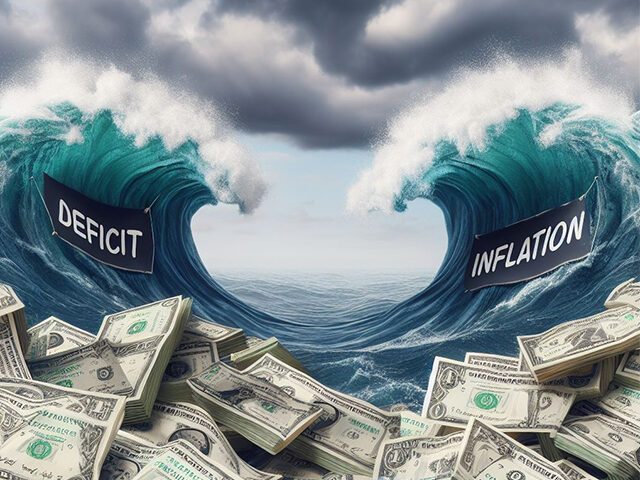The Deficit Was Even Bigger Than It Looked
If you want to know why progress on bringing down inflation has stalled, a good starting place for your investigation would be the federal budget deficit.
The federal government’s budget deficit effectively doubled over the year to $2 trillion, after distortions caused by President Joe Biden’s illegal student loan forgiveness plan are removed. Compared with the previous year, the budget deficit rose $1.02 trillion.
The official figure was a lower $1.7 trillion because of the way the government accounted for the Biden student loan scheme. Initially, the scheme was scored as $379 billion spending increase, running up the deficit in 2022 to $1.4 billion. When the scheme was shot down by the Supreme Court, this got recorded as a $333 billion spending cut for this year.
Clean up the mess created by Biden’s adventures in lawless loan forgiveness, and the 2022 deficit would have been smaller than reported, around $1 trillion. And this year’s deficit would have been even larger, around $2 trillion.
This brings the size of the deficit to around 7.5 percent of gross domestic product, according to the calculations of analysts at Bank of America. J.P. Morgan Chase analysts reckon this is one of the three worst expansions of the budget deficit in terms of GDP since 1950.
The timing of the other two is informative. The first was in fiscal year 2009, during the economic and financial crisis that followed the near-collapse of the financial sector in 2008, when the unemployment rate soared to 9.9 percent and GDP shrank 2.5 percent for the year. The other was 2020, during the height of the pandemic and lockdowns, when unemployment climbed to 14.7 percent and GDP plunged at an annual rate of more than 30 percent in the second quarter.
In other words, we saw the kind of rapid expansion of the budget deficit that we would normally only expect during a crisis. But the 2023 fiscal year saw the economy grow faster than expected, and more than three million people were added to payrolls.
And It Likely Kept Inflation Higher
So what does all this have to do with inflation? Every dollar of deficit spending becomes a dollar of net saving for the non-government portion of the economy. The government’s deficit creates a private sector surplus. This surplus can be very valuable during downturns or times of sluggish growth, especially when income is being drained away by trade deficits. But when the economy is already showing signs of strain from excess demand and insufficient supply, it easily turns into inflationary pressure.
Importantly, this past year’s deficit should not be viewed in isolation. Without some serious about-face in fiscal policy, it is likely that $2 trillion deficits will become the new normal for the budget. The U.S. economics team at Bank of America now expects a $1.8 trillion deficit in 2024, $1.9 trillion in 2025, and $2 trillion in 2026.
“What we’re really seeing is that $2 trillion is the new normal for deficits,” Marc Goldwein, senior policy director at the Committee for a Responsible Federal Budget, told Bloomberg News recently.
There’s a vicious cycle developing. A higher deficit pushes up inflation, which causes the Fed to push up interest rates. The higher interest rates cause the government to borrow more to fund the higher borrowing costs. Bank of America says it expects net interest expenses as a share of GDP to increase from 2.5 percent in the just concluded fiscal year to 3.5 percent this year, the highest on record.
That, in turn, will provide more fuel for inflation. How much the pro-inflationary effect of higher deficits due to higher interest rate expenses offsets the anti-inflationary effect of higher rates is not something even the most experienced practitioners of economic sorcery can be said to forecast with much accuracy.
The Third Quarter Growth Explosion
We are likely to see just how much all this deficit spending stimulated the economy when the government reports third-quarter GDP numbers on Thursday. The consensus view among economists polled by the Wall Street Journal is that the economy grew at a 4.7 percent annualized rate after adjusting for inflation. The Atlanta Fed’s GDPNow has the economy growing 5.4 percent. S&P Global estimates 5.6 percent.
The catchphrase at the Federal Reserve these days is: “Something’s got to give.” That was the title of a recent talk by Fed Governor Chris Waller, but it was also part of a speech given last week by Richmond Fed President Tom Barkin.
“So, if you believe the data, something’s got to give. Demand that strong isn’t the fix for inflation,” Barkin said.
Unfortunately, the early indications is that what’s giving way is not growth. The S&P Global “flash” surveys released Tuesday indicated the economy is accelerating in October compared with the previous two months. Services is growing faster, and manufacturing has flipped to expansion after spending most of the year in contraction territory.
So far, the inflation signals look benign. But it’s hard to see that lasting if the economy keeps growing so much faster than potential and the deficit keeps rising.

COMMENTS
Please let us know if you're having issues with commenting.